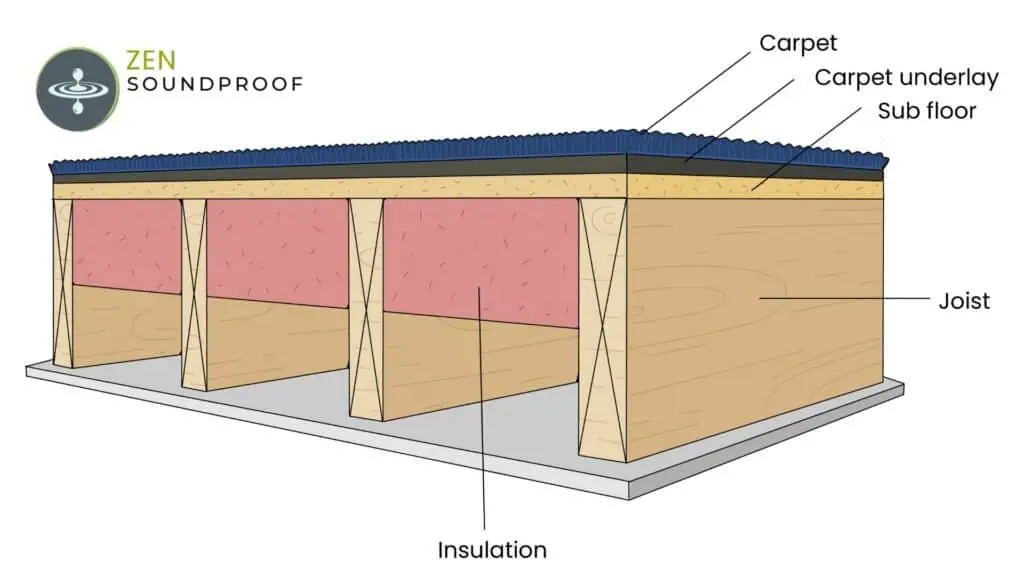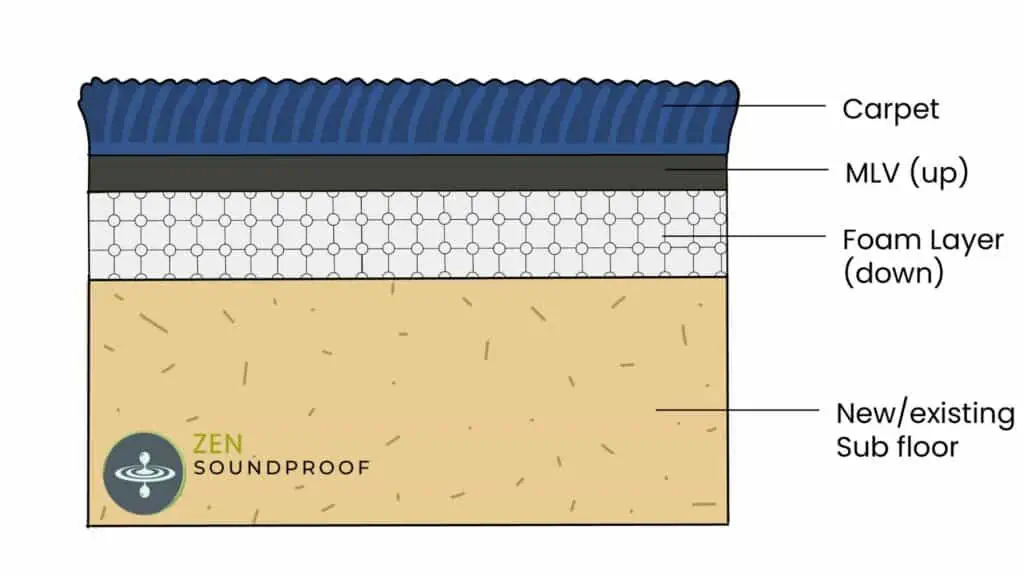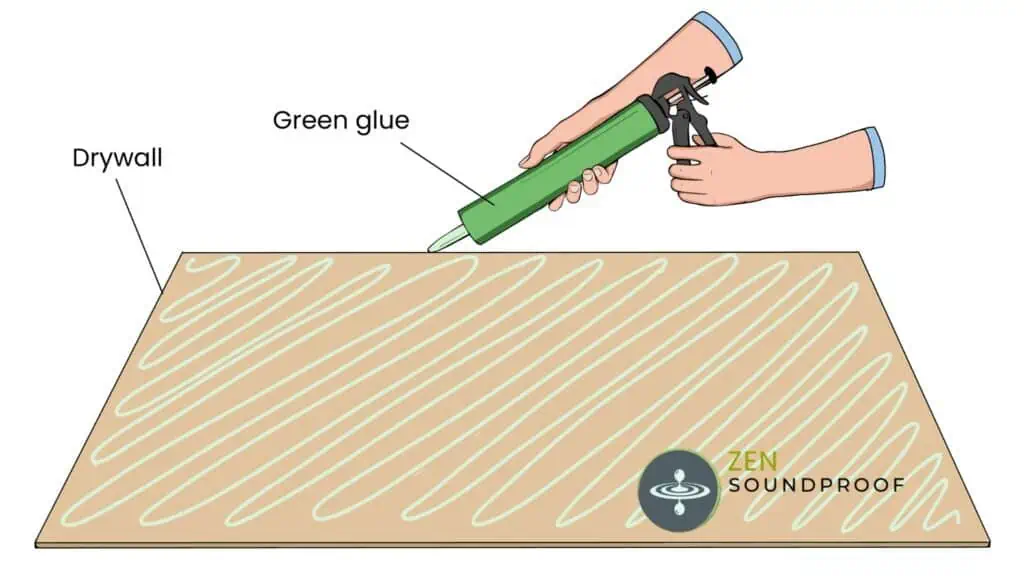During my years of studying soundproofing, I’ve found there’s plenty of confusion around how soundproof carpet flooring is. Without much specialist knowledge, it can be easy to assume that carpets and rugs will help reduce noise in a room.
However, once you dig into the science, you’ll realize this isn’t the case.
To soundproof under carpet, you’ll instead need to add other materials to address the key principles of soundproofing. If this sounds a bit vague, don’t worry, this is what I explain below. I’ll cover the key aspects of soundproofing before discussing ways to soundproof a carpet floor.
Identifying Different Types of Noise
I often find the best place to start with this kind of topic is by discussing noise itself. Sound waves are vibrational energy and what this energy passes (transmits) through determines what type of noise we’re dealing with.
We can break sounds down into 2 main types:
- Airborne noise is sound that travels from the source to our ears through the air. Examples include people talking, TV sounds, music, etc.
- Impact noise is created by an object making contact with a structure, which produces vibrational energy that transmits through the structure and out the other side. Some examples include footsteps, furniture being moved, a bouncing ball, etc.
Knowing what type of noise you’re dealing with is vital for choosing the right soundproofing solutions.
Specifically, airborne noise is blocked using absorption, dampening and mass, whereas impact sound is blocked using decoupling.
These concepts are known as the principles of soundproofing, which we can combine in different ways to deal with different types of sound. Check out that separate article for further information.
Can Carpet Soundproof a Floor?
Soundproofing is an umbrella term for different ways to deal with problem noise. As such, the answer to “can carpet soundproof a floor” is no, but also yes, to an extent. It depends on the type of noise and its intensity. But it also depends on the type of carpet.
Let’s dig a bit deeper into the various metrics we must balance to determine whether carpet can help soundproof a floor.
Carpet vs. Impact Noise
Carpet is a resilient material, meaning it can reduce or prevent sound propagation through structures. In short, a resilient material is one that can deform on impact and then return to its original state without passing on impact energy.
Essentially, it means it’s bouncy.
We use a metric called Impact Insulation Class (IIC) to measure a material’s ability to reduce impact sounds. According to the Carpet & Rug Institute, a carpet’s IIC rating is mainly determined by its pile weight.
As you might already know, carpet pile refers to the length of the looped fabric that makes up the carpet. Pile weight, therefore, is how heavy this fabric is based on its height, thickness, and density.
We measure pile weight in ounces per square yard (oz./sq. yd). Values range from 20-100, but standard household carpets sit between 35 and 60 oz.
For better impact reduction capabilities (better IIC), aim for the higher end of the spectrum.
Carpet vs. Airborne Noise
Carpet is more effective as a sound absorber – meaning it’s good against airborne noise. It’s important to note that sound absorption works against echo and reverberation rather than sound transmission in and out of a space. But carpet is good for reverb because it’s a soft material and has a high coverage area.
We measure sound absorption using a metric called Noise Reduction Coefficient (NRC). Values range between 0 and 1, and the closer to 1 it is, the higher the percentage of sound energy it absorbs. The NRC of carpet averages 0.30 and it can go as high as 0.55.
To clarify the information above, carpet is not a sound blocker. Sound blocking requires mass, which carpet lacks.
For example, the maximum pile weight of carpet is nearly 0.7 lbs. per sq. ft., which is drastically lower than mass loaded vinyl (2 lbs. per sq. ft.).
In fact, carpet’s density is less than half that of drywall, itself an average sound blocker. This comparison alone should be enough to demonstrate that carpet isn’t effective at blocking sound.
| MLV | Drywall | Carpet | |
|---|---|---|---|
| Thickness (in.) | 0.25 | 0.5 | 0.25 – 1 |
| Density (lbs/sq.ft) | 2 | 1.6 | Up to 0.7 |
Luckily, this is a weakness we can address with some ease using dedicated soundproofing products.
5 Ways to Soundproof Carpet Floors
Now that we have a better understanding of how carpet interacts with sound waves, we can look at solutions for soundproofing carpet floors. To an extent, the solutions below aim to supplement the existing characteristics of carpet – or at least address weaknesses.
Based on my observations of soundproofing my own living spaces, here are 5 ways to soundproof carpet floors.
1. Adding Underlayment or a Pad
Flooring underlayment is the bouncy layer you install under a carpet to improve the feeling underfoot. It comes in many different forms, some of which can help with soundproofing floors. Also, these products can help with laminate flooring, although that’s a harder product to soundproof in the first place.
Improving NRC Rating
Carpet underlay is useful for improving comfort and thermal insulation. However, it can improve your floor’s NRC rating by up to 0.2 points. This might not sound like much, but it makes a decent difference.

Improving IIC Rating
Perhaps a more significant effect is on the floor’s IIC rating. For this, we need to use a suitably resilient material that’s dense and fairly springy.
According to a study by the CRI, the best material for improving IIC is foam rubber because it strikes a good balance between thickness and density. The next best alternative is sponge rubber with a high density (80 oz, per sq. yd).
Improving STC Rating
Underlay can also help to improve the floor’s Sound Transmission Class (STC), which measures attenuation of airborne sound. However, it’ll need to be suitably dense enough. For example, Silentstep Premium underlay weighs 1.02 lbs. per sq. ft., which is about the same as mid-range MLV.
My Recommendation for Underlays
Some other helpful products that address both impact and airborne noise include:
- SecondSkin Underblock. It’s dense rubber that can be up to 12mm thick. I discuss it more in my article on soundproof carpet padding, so check that out for a full writeup.
- This soundproof underlay from the Sound Isolation Company. It includes a layer of MLV and can have a density of up to 2 lbs. per sq. ft. It can add up to 32 points of STC, making it more effective than adding a layer of drywall to the structure.
The bottom line is that there are numerous ways to address soundproofing through carpet underlay. Your best bet is to figure out a budget, how much room you have to play with, and the type of noise pollution you need to address. Balancing these will help you find the best soundproof underlay for your needs.
2. Adding a Layer of Mass Loaded Vinyl
If airborne noise is your main issue, adding a layer of mass loaded vinyl (MLV) can be a good way to deal with it. MLV works by adding density and mass to the structure, specifically limp mass. In simple terms, this means it doesn’t transmit sound waves, instead dissipating them.
However, it’s worth noting that MLV won’t:
- Help with impact noise because it’s not sufficiently resilient. While airborne sound waves dissipate off it, it’s not squishy enough to cushion impacts.
- Serve as an underlay because it’s too thin. Although generally a benefit of MLV, in this case, its thinness is a downside, as it won’t feel good under your feet.
If you don’t already have carpet underlayment and want to add MLV too, you could use the product I link above. Alternatively, you’d need a layer of MLV and a separate underlay, which could add a lot of thickness to your flooring.
To understand more about MLV, check out my article on how MLV works. Also, to address the flooring issue, you could make your own DIY carpet pad.
Essentially, you’ll need to combine mass loaded vinyl with polyurethane foam. This offers a good combination of resilient material and density to provide comfort and sound blocking.
You’ll want to install the MLV over the foam to get the best from both products, as this allows the MLV to remain limp.

Building a DIY carpet pad like this can get pretty expensive, so another option would be to consider a product like this underlay from Trademark Soundproofing. It does the same job and delivers the same results.
3. Add a Layer of Drywall or Plywood Over the Subfloor
Subfloor refers to the material that goes over the floor/ceiling joists, onto which you fix underlay, carpet, etc. It’s the structural element that you build flooring onto, and you’ll find it in every floor setup.
I probably don’t need to explain what drywall and plywood are, as they’re very common building materials. We can use them in soundproofing projects to add mass and density to the existing floor. As such, adding them addresses airborne noise.
Improving STC with Drywall
While there are more effective products (such as MLV), the advantages of plywood and drywall are that they’re less expensive and more easily accessible. Other products with similar densities include OSB (oriented strand board) and MDF.
Drywall on its own has an STC rating of around 32, and the other products hover around this, too. But as I discuss in my MLV article, adding more drywall to a structure only adds a maximum of 5 STC points at a cost of $90 per STC point gained.
Therefore, it looks less expensive on the surface, but when we actually look at the objective results, we can see this might not be the case. Its advantage instead comes from the fact that it’s easy to install.
To do so, you’d simply screw layers of it to the subfloor, fixing it to the joists. Although screws can create transmission pathways for sound, it’s not a major issue in a household setup.
4. Apply Green Glue Between Subfloor and Drywall
Technically, this is an extra step for adding drywall to the subfloor. It deserves its own entry though, as Green Glue is a separate soundproofing product. Green Glue makes 2 products, but the one we’re interested in here is the acoustic caulk.

In simple terms, it works the same as silicone sealant. Acoustic caulk seals gaps and provides a separating layer (in this case) between the subfloor and drywall. However, its advantage over traditional sealants is that it’s made from latex, meaning it never fully cures. As such, it retains elasticity that helps with noise dampening.
Bear in mind, Green Glue only helps with airborne noise. The company only advertises improvements to STC ratings, which is a metric used for airborne sound. While a thick enough layer applied to the subfloor may help with impact sound, it would be too difficult to achieve decent results.
Applying Green Glue is fairly easy. You can check out this video from the company for a visual guide. The steps would be the same, except you’ll be applying it to a floor rather than a wall.
5. Add a Layer of Acoustic Carpet Tiles
Acoustic carpet tiles are squares of carpet that have acoustic foam backing. Although the carpet itself is usually quite thin, the acoustic foam is a decent product to absorb sound waves. It’s therefore helpful for airborne noise (reducing reverb and echo rather than blocking noise transmission), but will also help to some extent with impact noise.
Most acoustic floor tiles are modular in that they’re square and are butted up next to each other. Some have rubber backing, so would stick easily to an existing carpet. Others are interlocking, and you also have self-adhesive options.
The acoustic foam is what’s doing the work here, so we’d measure their effect using NRC ratings.
Improving NRC with Acoustic Floor Tiles
However, it can be difficult to find verified tests to show this. These carpet tiles from Orca have an NRC rating of 0.40, which is a mid-range result for actual carpet. Expect other products to offer similar results based on the thickness of the materials.
There is a notable limitation of adding carpet tiles, though, especially if you use thick ones. Combined with the carpet itself, you might make the flooring setup too tall, preventing doors from shutting.
Considering we’re working on reducing sound transmission, having a permanently open door won’t help!
Soundproof Carpet (Related Questions)
Does Carpet Reduce Sound?
Carpet doesn’t reduce sound because it’s not a sound blocker on its own. Its lack of density, combined with its porous nature, means it’s lacking the properties to block sound. As discussed, the main properties for blocking sound are mass and density.
Instead, carpet is a sound absorber. This means it helps reduce echo and reverberation, which refer to sound waves bouncing around a room. I explain the difference more in my article on soundproofing vs. sound absorption, so check that out.
Absorption is a useful quality in soundproofing projects but, importantly, it doesn’t reduce sound.
What Sort of Soundproofing Carpet is Best?
Carpet is a resilient material, meaning it improves a structure’s IIC rating. To get decent results for reducing impact noise using its resilience properties, you’ll need a carpet with a tall pile height and high pile weight. Something around 70 oz. per sq. yd (the top of the domestic carpet weight scale) will be best.
However, against airborne noise, carpet doesn’t offer good “soundproofing”. It isn’t dense enough to block airborne sounds from transmitting through a floor. For example, the average carpet density of 0.7 lbs. per sq. ft. is less than half that of drywall (1.6 lbs. per sq. ft.).
Considering drywall has average sound blocking properties, this should illustrate how ineffective carpet is at blocking airborne noise.
It’s very effective at sound absorption, though. While absorption is a branch of the overall concept of soundproofing, it’s also quite different. Most people regard soundproofing as blocking noise, and this isn’t what absorption does.
As mentioned, absorption reduces echo and reverb. This means it helps to improve sound quality – simply making it sound better. Carpet is therefore useful for improving the acoustics in domestic settings such as TV rooms, home theaters, recording studios, etc.
Final Thoughts
I hope this article has clarified how you can utilize carpet in a soundproofing project. To recap, carpet itself has some useful properties, but luckily there are plenty of materials that can help address its weaknesses.
For best effect, I recommend finding a decent carpet underlay that incorporates some soundproofing materials. Something with foam rubber and MLV will be a good combination. Failing that, make your own out of the same materials.
Do you have any other tips for improving the soundproof qualities of a carpeted floor? Drop them in the comments section below!
